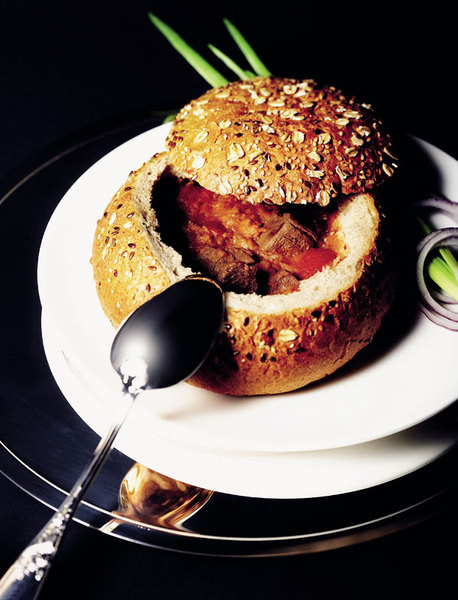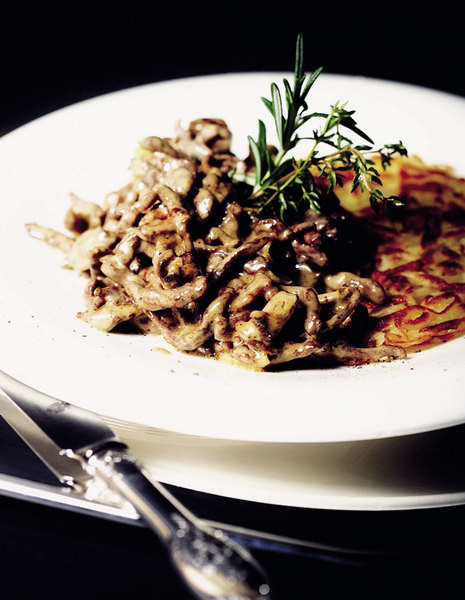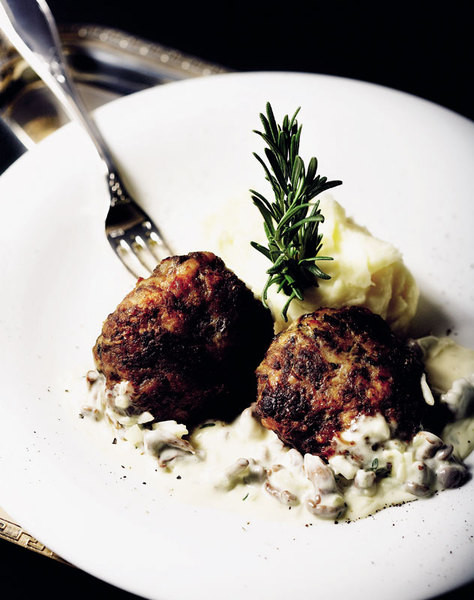 Game recipesGame is not a type of food,but rather a genre. A kind of literary-culinary-sporting exercise that insistently requires not only the spiciness of the seasonings, but also the spiciness of the plot. Ideally, of course, it would be good if it turned out like in the film "Gosford Park": gather at a country estate, change into special hunting suits the next morning (a separate song - to show off your knowledge of etiquette); before taking the life of a couple of speckled-tailed birds, weave some intricate intrigue; be amazed at your own accuracy (or, on the contrary, proclaim that aiming at a living creature is repugnant to you - it's a different matter to meet it, already plucked, on a plate); and also be sure to eat dinner in a special hunting lodge, where the servants have delivered the family china and silver in advance (a pinch of detective fiction in addition, of course, would not hurt, plus - since we are talking about literature - you could while away the time in ambush, recalling the words from Tolstoy - all these "dozhzhachi", "vyzhlyatniki", "stirrupnye", which are now not found outside of scholarly commentary). But even if we discard armed social receptions, there is still a whole (and long) story with game. For a start, no one will drag a freshly slaughtered carcass to the table. The catch must hang on the hook for some time (pheasant and woodcock, the French teach, - four days; deer and wild boar - almost a week), then soak in marinade (at least - a day, or even three) and only then get to the cook, who will start wrapping in bacon, stuffing with truffles, frying, smoking, pouring with jam and other machinations, intricate and not so. The thing is this: before meeting the hunter, the deer (or even the quite prosaic hare) spent time in a much more interesting way than a cow or a chicken. Adventures, chases; fresh air, again. Ecologically clean food. The result is the same as a person would have if he followed all the covenants of doctors and trainers: solid muscles, no fat. It is no wonder that they have to be softened and soaked.
Game recipesGame is not a type of food,but rather a genre. A kind of literary-culinary-sporting exercise that insistently requires not only the spiciness of the seasonings, but also the spiciness of the plot. Ideally, of course, it would be good if it turned out like in the film "Gosford Park": gather at a country estate, change into special hunting suits the next morning (a separate song - to show off your knowledge of etiquette); before taking the life of a couple of speckled-tailed birds, weave some intricate intrigue; be amazed at your own accuracy (or, on the contrary, proclaim that aiming at a living creature is repugnant to you - it's a different matter to meet it, already plucked, on a plate); and also be sure to eat dinner in a special hunting lodge, where the servants have delivered the family china and silver in advance (a pinch of detective fiction in addition, of course, would not hurt, plus - since we are talking about literature - you could while away the time in ambush, recalling the words from Tolstoy - all these "dozhzhachi", "vyzhlyatniki", "stirrupnye", which are now not found outside of scholarly commentary). But even if we discard armed social receptions, there is still a whole (and long) story with game. For a start, no one will drag a freshly slaughtered carcass to the table. The catch must hang on the hook for some time (pheasant and woodcock, the French teach, - four days; deer and wild boar - almost a week), then soak in marinade (at least - a day, or even three) and only then get to the cook, who will start wrapping in bacon, stuffing with truffles, frying, smoking, pouring with jam and other machinations, intricate and not so. The thing is this: before meeting the hunter, the deer (or even the quite prosaic hare) spent time in a much more interesting way than a cow or a chicken. Adventures, chases; fresh air, again. Ecologically clean food. The result is the same as a person would have if he followed all the covenants of doctors and trainers: solid muscles, no fat. It is no wonder that they have to be softened and soaked. Roe deer with chanterelles and rösti potatoes with creamy saucesauce. Plus - a sharp, bright, almost impudent taste. Any wild bird compared to a goose or chicken - is about like an Indian landscape compared to a central Russian one, or unpainted canvas next to an embroidered sari. A creature whose ancestors all sat in cages, for a cook - is nothing more than a background, a basis on which to build all sorts of flavor constructions - from an elementary juxtaposition of flavors, reminiscent in architecture of Carlson's tower made of meatballs, to baroque patterns with seasonings, broths, side dishes, decorations and sauces. Game requires a completely different treatment. It is an absolute soloist - it just may need an orchestra to accompany it; at least a chamber one, made of marinade and a few seasonings; at most – symphonic, in the classic French style (with precious ingredients like truffles and cleverly wrapped sauces). It is not surprising that nations that are generally unnoticed in other gastronomic subtleties go hunting for game – for example, the Czechs. They are simply lucky: they have forests and mountains. And, as a result, castles with branching antlers on the walls and wild boars, pheasants, hares, roe deer and bears in butcher shops and restaurant menus. All these creatures (called by the wonderful word «zveržina») are simply marinated by simple Central Europeans, and then boiled or fried, poured with wine and berry sauces (or wrapped, say, in bacon). It turns out, surprisingly, – fireworks (which produce an effect that is all the more deafening because we are not used to expecting any culinary revelations from our closest Western neighbors). In principle, Russian chefs are thinking in the same direction, composing the menu for ceremonial Kremlin dinners and heartfelt inter-presidential conversations in Strelna. It is not that roe deer is the secret of the notorious new Russian cuisine - not at all; the idea of amazing your dining companion with game is as old as ice swan with black caviar or the toast "na zdorovye", - but it will inspire respect in any case.
Roe deer with chanterelles and rösti potatoes with creamy saucesauce. Plus - a sharp, bright, almost impudent taste. Any wild bird compared to a goose or chicken - is about like an Indian landscape compared to a central Russian one, or unpainted canvas next to an embroidered sari. A creature whose ancestors all sat in cages, for a cook - is nothing more than a background, a basis on which to build all sorts of flavor constructions - from an elementary juxtaposition of flavors, reminiscent in architecture of Carlson's tower made of meatballs, to baroque patterns with seasonings, broths, side dishes, decorations and sauces. Game requires a completely different treatment. It is an absolute soloist - it just may need an orchestra to accompany it; at least a chamber one, made of marinade and a few seasonings; at most – symphonic, in the classic French style (with precious ingredients like truffles and cleverly wrapped sauces). It is not surprising that nations that are generally unnoticed in other gastronomic subtleties go hunting for game – for example, the Czechs. They are simply lucky: they have forests and mountains. And, as a result, castles with branching antlers on the walls and wild boars, pheasants, hares, roe deer and bears in butcher shops and restaurant menus. All these creatures (called by the wonderful word «zveržina») are simply marinated by simple Central Europeans, and then boiled or fried, poured with wine and berry sauces (or wrapped, say, in bacon). It turns out, surprisingly, – fireworks (which produce an effect that is all the more deafening because we are not used to expecting any culinary revelations from our closest Western neighbors). In principle, Russian chefs are thinking in the same direction, composing the menu for ceremonial Kremlin dinners and heartfelt inter-presidential conversations in Strelna. It is not that roe deer is the secret of the notorious new Russian cuisine - not at all; the idea of amazing your dining companion with game is as old as ice swan with black caviar or the toast "na zdorovye", - but it will inspire respect in any case. Wild boar cutlets with mushroom sauce and potatopuree. Further proof of the self-sufficiency of game is Tuscan cuisine. On the one hand, it is shrouded in legends and gentle spring winds, saturated with marvelous aromas, sanctified by all conceivable authorities, from Pavel Muratov to Jamie Oliver, and on the other hand, it is deliberately lapidary, almost crude. In Tuscany, they like to make a rather unambiguous, but highly memorable ragout from wild boar (or hare) and roll wide flat pasta - pappardelle - in it. And also serve something sharp and provocative as an accompaniment, like the songs of Celentano, Brunello, for example. There is no desire to reflect on this combination, dissect it, analyze it. You just want to swallow it quickly and demand, if possible, more. This is food for very hungry people who are capable, having eaten their fill, of experiencing absolutely complete happiness, unclouded by any troubles - either personal or global. Of course, it is possible in another way. You can resort to the classics (that is, to the French tradition) and get a complex masterpiece, each piece of which is worthy of a full-fledged gastronomic sonata (in a rather major spirit, reminiscent of, say, Mozart). Savor it, unhurriedly, not forgetting to follow the flow of the conversation, invent a detective story with the participation of those present - and imagine if not the court of one of the Louis, then at least an English estate, caustic countesses, well-trained servants, a ride at dawn and dinner in a hunting lodge. Who is considered game? The French, the leading experts in the field of game, divide it primarily into four-legged and winged. Four-legged game can be large (deer, roe deer, wild boar) and small (hare, wild rabbit). Winged game, in turn, is divided into forest, or forest (hazel grouse, black grouse, wood grouse, pheasant, partridge), field and steppe (again partridges, as well as thrushes, larks, plovers, garden warblers), waterfowl (ducks, geese, swans) and marsh (woodcock, snipe, great snipe, marsh hen). It is best to order game in restaurants in season, that is, in the fall (in general, the best months are September and December). However, frozen meat from New Zealand is delivered practically all year round.
Wild boar cutlets with mushroom sauce and potatopuree. Further proof of the self-sufficiency of game is Tuscan cuisine. On the one hand, it is shrouded in legends and gentle spring winds, saturated with marvelous aromas, sanctified by all conceivable authorities, from Pavel Muratov to Jamie Oliver, and on the other hand, it is deliberately lapidary, almost crude. In Tuscany, they like to make a rather unambiguous, but highly memorable ragout from wild boar (or hare) and roll wide flat pasta - pappardelle - in it. And also serve something sharp and provocative as an accompaniment, like the songs of Celentano, Brunello, for example. There is no desire to reflect on this combination, dissect it, analyze it. You just want to swallow it quickly and demand, if possible, more. This is food for very hungry people who are capable, having eaten their fill, of experiencing absolutely complete happiness, unclouded by any troubles - either personal or global. Of course, it is possible in another way. You can resort to the classics (that is, to the French tradition) and get a complex masterpiece, each piece of which is worthy of a full-fledged gastronomic sonata (in a rather major spirit, reminiscent of, say, Mozart). Savor it, unhurriedly, not forgetting to follow the flow of the conversation, invent a detective story with the participation of those present - and imagine if not the court of one of the Louis, then at least an English estate, caustic countesses, well-trained servants, a ride at dawn and dinner in a hunting lodge. Who is considered game? The French, the leading experts in the field of game, divide it primarily into four-legged and winged. Four-legged game can be large (deer, roe deer, wild boar) and small (hare, wild rabbit). Winged game, in turn, is divided into forest, or forest (hazel grouse, black grouse, wood grouse, pheasant, partridge), field and steppe (again partridges, as well as thrushes, larks, plovers, garden warblers), waterfowl (ducks, geese, swans) and marsh (woodcock, snipe, great snipe, marsh hen). It is best to order game in restaurants in season, that is, in the fall (in general, the best months are September and December). However, frozen meat from New Zealand is delivered practically all year round.

Making Money with Desserts: Success Stories
Evgeniya Polischuk (Fedutinova) instagram:@evgeniyafedutinovavk.com/janeshomebaking– It all started with baking for family and friends. Gradually, I started posting photos of my baked goods on Instagram – and orders started coming in. I made my first custom-made cake on October 13, 2014, and a little earlier I started making macaroons and cupcakes. You could say that the business “found me”, I am very […]

Soups are cold recipes with photos
Cold cucumber soup with yogurt and lemonsorbet from the chef of the restaurant La Taverna Alexander Zhurkin Photo: Getty Images Ingredients: Plain yoghurt – 125 g Cucumber – 150 g Lemon/lime sorbet – 50 g Cocktail shrimp – 24 g Fresh ginger juice – 1 g Lime juice – 5 g Fresh orange juice – 5 g Parsley – 1 g Pink pepper – 1 g Watercress – […]

barbeque kebab
Pork tenderloin in glaze Photo:Dmitry Bayrak/dbstudioPreparation time: 20 minutes + marinating time.Calories: 454 kcal per serving.For 4 servings: 4 pork tenderloins (approximately 300 g each), 1 onion, 2 cloves of garlic, 1 tsp. lemon zest, 1 tsp. lemon juice, a pinch of ground cumin, coriander and turmeric, 1 tbsp. vegetable […]

Pierre Duacan: dietary recipes: Ducane diet
Beetroot soup Photo:Season’S, Luxury Hotels RepresentationYou will need:· Boiled beetroot – 60 g· Fresh cucumbers – 20 g· Red radish – 20 g· Green onions – 10 g· Egg – 1 pc.· Drinking mineral water – 200 g· Salt – 1 gPreparation:· Boil the egg and beetroot.· Grate the cucumbers, radish and part of the beetroot. Put everything […]





